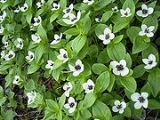
Cornaceae
Encyclopedia
Cornaceae is a cosmopolitan family of flowering plants in the order Cornales
. It contains approximately 110 species, mostly trees and shrubs, which may be deciduous or evergreen. Members of this family usually have opposite or alternate simple leaves, four- or five-parted flowers clustered in inflorescence
s or pseudanthia
, and drupaceous
fruits. In northern temperate areas, Cornaceae is well known from two genera: Cornus
, the dogwoods, and Nyssa
, the tupelos.
The systematics
of Cornaceae have been remarkably unsettled and controversial, and many genera have been added to it and removed from it over time. (One researcher called it a "dustbin.") Molecular phylogenetics have clarified the relatedness of some associated genera, and at least nine genera that were previously included in Cornaceae have been eliminated from the order Cornales entirely, but the circumscription of Cornaceae is still unclear. The Angiosperm Phylogeny Group
usually defines Cornaceae as comprising the genera Cornus and Alangium
as well as the five genera often separated into the family Nyssaceae
. However, many of these genera are sometimes split off into their own families (e.g. Alangiaceae
), and the usage remains inconsistent.
Cornales
Cornales is an order of flowering plants, basal among the asterids, containing about 600 species. Plants within Cornales usually have four-parted flowers, drupaceous fruits, and inferior gynoecia topped with disc-shaped nectaries...
. It contains approximately 110 species, mostly trees and shrubs, which may be deciduous or evergreen. Members of this family usually have opposite or alternate simple leaves, four- or five-parted flowers clustered in inflorescence
Inflorescence
An inflorescence is a group or cluster of flowers arranged on a stem that is composed of a main branch or a complicated arrangement of branches. Strictly, it is the part of the shoot of seed plants where flowers are formed and which is accordingly modified...
s or pseudanthia
Pseudanthium
A pseudanthium or flower head is a special type of inflorescence, in which several flowers are grouped together to form a flower-like structure. The real flowers are generally small and greatly reduced, but can sometimes be quite large...
, and drupaceous
Drupe
In botany, a drupe is a fruit in which an outer fleshy part surrounds a shell of hardened endocarp with a seed inside. These fruits develop from a single carpel, and mostly from flowers with superior ovaries...
fruits. In northern temperate areas, Cornaceae is well known from two genera: Cornus
Dogwood
The genus Cornus is a group of about 30-60 species of woody plants in the family Cornaceae, commonly known as dogwoods. Most dogwoods are deciduous trees or shrubs, but a few species are nearly herbaceous perennial subshrubs, and a few of the woody species are evergreen...
, the dogwoods, and Nyssa
Tupelo
The tupelo , black gum, or pepperidge tree, genus Nyssa , is a small genus of about 9 to 11 species of trees with alternate, simple leaves...
, the tupelos.
The systematics
Systematics
Biological systematics is the study of the diversification of terrestrial life, both past and present, and the relationships among living things through time. Relationships are visualized as evolutionary trees...
of Cornaceae have been remarkably unsettled and controversial, and many genera have been added to it and removed from it over time. (One researcher called it a "dustbin.") Molecular phylogenetics have clarified the relatedness of some associated genera, and at least nine genera that were previously included in Cornaceae have been eliminated from the order Cornales entirely, but the circumscription of Cornaceae is still unclear. The Angiosperm Phylogeny Group
Angiosperm Phylogeny Group
The Angiosperm Phylogeny Group, or APG, refers to an informal international group of systematic botanists who came together to try to establish a consensus on the taxonomy of flowering plants that would reflect new knowledge about plant relationships discovered through phylogenetic studies., three...
usually defines Cornaceae as comprising the genera Cornus and Alangium
Alangium
Alangium is a small genus of flowering plants. The genus is included either in a broad view of the dogwood family Cornaceae, or as the sole member of its own family Alangiaceae. Alangium has about 24 species, but some of the species boundaries are not entirely clear...
as well as the five genera often separated into the family Nyssaceae
Nyssaceae
Nyssaceae is a small family of flowering trees closely related to and often included within the dogwood family . Nyssaceae commonly includes the following genera:...
. However, many of these genera are sometimes split off into their own families (e.g. Alangiaceae
Alangiaceae
Alangiaceae is a small family of small dicotyledon trees, shrubs or lianas, closely related to the Cornaceae .There is only one genus, Alangium, with seventeen species....
), and the usage remains inconsistent.

